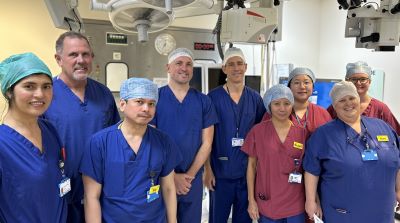4 June 2024
A groundbreaking eye operation could give hope to patients currently on the national waiting list for human corneal transplants.
The procedure is a type of corneal implant called endothelial keratoplasty which involves removing the abnormal inner lining of the cornea (endothelium), and replacing it with an artificial cornea, rather than a donated human one.
 Frimley Health’s highly experienced consultant ophthalmologist, Mr Thomas Poole, with his consultant colleague Miss Hanbin Lee, have successfully performed the procedure on four patients in the last two months and initial results have shown an improvement in vision and a reduction in corneal thickness.
Frimley Health’s highly experienced consultant ophthalmologist, Mr Thomas Poole, with his consultant colleague Miss Hanbin Lee, have successfully performed the procedure on four patients in the last two months and initial results have shown an improvement in vision and a reduction in corneal thickness.
Patient Cecil Farley, 91, from Chobham in Woking said: “I’m really glad I had the procedure as I had no vision in my right eye at all. I’d previously had a human graft which failed so I was very happy to be the first patient to receive an artificial cornea. My vision in that eye is slowly improving, it can take up to a year to work fully but my sight is getting clearer week by week. I’ve been married for 63 years and can still see my wife so I’m hoping the vision will continue to progress.”
There is a worldwide shortage of donated human corneas and up to a two year waiting list for transplants in the UK. According to research presented to the Royal Society of Medicine, last summer, the UK needs to make available 350 eyes a week for treatment and research but currently only manages 88.
Tom Poole, consultant ophthalmologist, Frimley Health NHS Foundation Trust said: “There is a delay in patients getting treatment because of the national shortage of available corneas. In selected cases, artificial corneas could be used giving patients quicker access to treatment and therefore improved sight.
“The artificial cornea has several advantages: there is no rejection risk as in human corneal grafts, no risk of disease transmission, and if successful, no long-term future risk of graft failure, which can affect human donor corneas. The procedure is minimally invasive, which reduces the risk of further injury to the fragile eye tissue.
“This is a very exciting step forwards in improving the vision of some of our patients with corneal disease who might otherwise face a long wait for a human cornea. It is early days for this new artificial cornea, with only 200 implanted worldwide to date, so we are using it in eyes with other comorbidities to start with, but I can see a future where an artificial cornea becomes standard treatment for all corneas with endothelial disease.”
 The artificial cornea, called EndoArt®, was designed and developed by ophthalmological medical device company EyeYon Medical. The synthetic implant has a similar appearance to a contact lens and was created to treat corneal oedema (swelling of the cornea), a problem of several eye diseases.
The artificial cornea, called EndoArt®, was designed and developed by ophthalmological medical device company EyeYon Medical. The synthetic implant has a similar appearance to a contact lens and was created to treat corneal oedema (swelling of the cornea), a problem of several eye diseases.
Charles Holmes, Chief Commercial Officer, EyeYon Medical said: “EndoArt® is the first artificial endothelial layer, a promising treatment for select eyes with chronic corneal oedema. EndoArt® represents a new hope to patients who are suffering from chronic corneal oedema as an alternative to human tissue.”
The cornea is the clear outer layer at the front of the eyeball which acts as a window to the eye. It helps to focus light rays on to the retina (the light-sensitive film at the back of the eye) and this "picture" is then transmitted to the brain. When the cornea is damaged as a result of injury, disease, or many common eye conditions, it can become less transparent or its shape can change. This can prevent light reaching the retina and causes the picture transmitted to the brain to be distorted or unclear.

